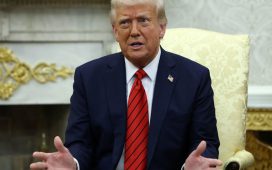Stay informed with free updates
Simply sign up to the On Wall Street myFT Digest — delivered directly to your inbox.
The writer is co-author of The Smartest Guys in the Room and The Big Fail: What the Pandemic Reveals About Who America Protects and Who it Leaves Behind
Legislators and regulators give a great deal of lip service to the importance of small banks and small business — but in reality, their actions almost always aid the big at the expense of the small, particularly when it comes to banks. Yet without small banks, small business will struggle.
Starting with bank deregulation in the 1980s, and then the response to the global financial crisis, we’ve made big banks bigger at the expense of the small. This despite the fact the crisis was caused by the big banks, not the small ones (and the small ones didn’t need bailouts). From 2002 to 2022, the number of banks insured by the Federal Deposit Insurance Corporation declined by nearly half.
The unofficial policy of the US Treasury — although not of Congress — was long to consolidate banks, the theory being that bigger was safer. Even before Congress abolished the Glass Steagall Act in 1999 that had forced banks to separate commercial and investment banking, the Treasury had proposed its own plan to in effect do that and remove interstate banking restrictions to speed consolidation. Wall Street feels similarly. Following the collapses of Silicon Valley Bank and Signature Bank, some dismissed the very need for small banks.
“Perhaps the comments about the value of small and medium sized banks (and their small and medium sized clients) is just lip service and the goal is to get our system to look like the one in Europe,” says the lobbyist for one medium-sized bank. “It does not add up otherwise.”
Robert Kaplan, former president of the Dallas Fed, adds: “The big have gotten relatively stronger and the small and midsized banks are at more of a competitive disadvantage.
“This is the opposite of what we wanted to do coming out of the financial crisis of 2008, which was to avoid creating a system where power is concentrated in the hands of banks that are too big to fail.”
Many small banks feel that the response to the SVB crisis made matters worse. The government demonstrated that if a bank is big enough, and its depositors powerful enough, there is no limit on deposit insurance. But the government couldn’t or wouldn’t insure all deposits, leaving small banks at a terrible competitive disadvantage. That explains why small banks lost $120bn in deposits during the tumult over SVB.
“If we’re really trying to compete against folks that basically have a free blanket where there’s no need for the top five to offer insurance on their deposits, what can I do?” Scott Hildenbrand, a bank analyst at Piper Sandler, told the Bloomberg’s Odd Lots podcast. He predicts the number of US banks could decline from around 4,000 to maybe a couple of hundred over the next 10 to 15 years. A small bank CEO worries that just as we have food and healthcare deserts, we might have bank deserts — unbanked areas of the country.
Regulatory policies have also pushed money into non-banks — for instance, non-bank lenders now originate more mortgages than banks — despite the knowledge of the risks of the less regulated shadow banking system. Under the guise of helping small banks by taking loans off their books, so called “private credit” is also cutting into bank market share.
The pandemic also showed the limits of support for small business. The government helped small business with policies like the Paycheck Protection Program. But that help suffered from the chaotic nature of its rollout in comparison with the targeted bailout of large industries. And the Federal Reserve’s rescue packages helped big companies access the markets. Then lockdowns and supply chain issues disproportionately hurt small businesses that didn’t sell online and didn’t have the muscle to get the goods they needed.
Those who argue that we don’t need small banks are wrong. Big banks aren’t interested in providing tiny loans to local companies, and small companies don’t have the scale to raise cash in the markets. As Kaplan says, small and midsize banks are a lifeline for the small and midsize businesses that create a lot of jobs in the US.
“Many of the nation’s small and midsized banks are ‘scrubbing” their loan books in the effort to preserve capital,” adds Kaplan. “This has translated into raising the bar for loans to small and midsize businesses who are highly dependent on these banks’ lending services in order to run and grow their businesses.”
In the wake of the pandemic, there’s been a wave of start-ups. It’s some of those businesses that will lead the way out of a recession, if there is one, because small business always leads the way out. We need to figure out policies that protect them, and small banks.






